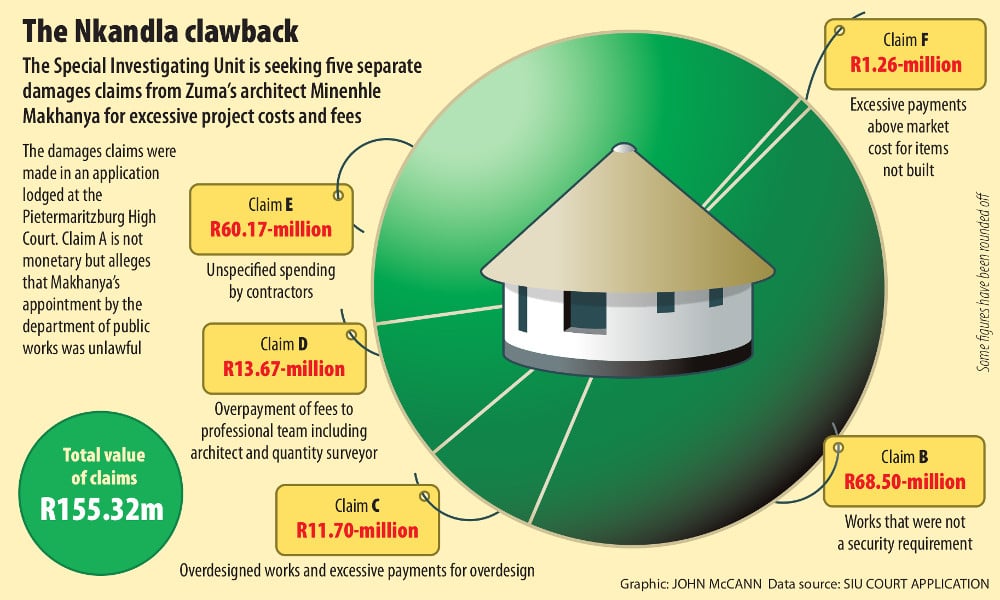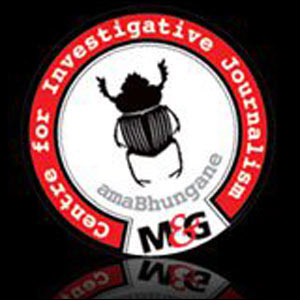The SIU is squeezing Minenhle Makhanya
As Zuma’s private architect, Minenhle Makhanya can disclose exactly what Zuma knew about the “security upgrade” that transformed the president’s modest Nkandla compound into a rural palace.
The Special Investigating Unit (SIU) this week slapped a R155-million noose around Makhanya’s neck. On Monday it lodged the massive claim against Makhanya, the architect Zuma appointed to extend his homestead prior to assuming the presidency in May 2009.
It marks the first time since the Scorpions charged Shaik that a law enforcement agency has taken aim at a close associate of Zuma.
Although Makhanya is likely to fight back – he has maintained a stony public silence throughout the Nkandla scandal – the SIU attempt to put him in what amounts to a life-long financial vice raises the stakes for the president.
Experts in the field of recovering state money this week said Makhanya would almost certainly have to provide evidence under oath to dispute the SIU claim, and would only be able to mount an effective defence by giving details about how and why the extra R155-million came to be spent on Nkandla.
Avoiding liability, they said, would require showing orders from above – and each step up the ladder of responsibility could bring new individuals into the pool of those who can be held responsible.
Following Zuma’s inauguration, the department of public works simply appointed Makhanya as its own agent to implement state-mandated security features at Nkandla.
The SIU says this appointment flouted procurement rules and was unlawful.
The unit accuses Makhanya of wasting millions of tax rands by authorising features not recommended by the official security assessment, including landscaping, air conditioning, escape tunnels and lifts.
Intermediary
Zuma has repeatedly claimed ignorance of the government’s decisions about Nkandla, but Makhanya was a key intermediary between the department and the president and may contradict Zuma’s version and put him in the firing line.
Public protector Thuli Madonsela’s report and project documents obtained by amaBhungane identify many instances when Zuma was consulted, notably by Makhanya, and how the president’s needs shaped the government’s actions.
It was Zuma himself who introduced Makhanya to public works officials at his home in Nkandla in August 2009. According to minutes, Makhanya was directed to canvass many decisions with “the principal” (the president), including “the road surface required for the driving of tractors”; plans for the landscaping and “fire pool” (the now infamous swimming pool); and the design of the bullet-resistant windows.
The public protector’s report noted: “Throughout the Nkandla project, [Makhanya] served as the go-between between the government officials and the president, leaving it to him to discuss designs with and explain the president’s preferences … even a minister could have had difficulty countermanding Mr Makhanya.”
The SIU summons also adds fuel to speculation that the department’s payments might have cross-subsidised Zuma’s private construction work.
But Zuma has strenuously denied what he termed allegations “that the government built my home in Nkandla”.
The public works ministry has previously claimed that every payment can be justified and nothing was paid “for anything relating to building of private residences except for security-related matters”.
But the SIU says Makhanya unlawfully approved payments of R60-million for civil and electrical works without properly accounting for what the payments were for or whether the work was done.

Departmental documents released to amaBhungane showed that the private and public projects partly overlapped and that the allocation of public and private costs was neither clear nor undisputed.
The public protector’s report noted: “I am not able to establish if costs relating to [Zuma’s] private renovations were separated from those of the state …”
AmaBhungane understands the SIU investigators asked all the private contractors whether they would be prepared to provide the unit with documentation relating to the private portion of the building work at Nkandla, but they refused.
Makhanya’s lawyer, Asif Latib, confirmed that the SIU had asked Makhanya to disclose the details of the private contract between himself and Zuma.
Latib said his client “answered those questions to the best of his ability”.
High stakes
The SIU summons against Makhanya is an audacious but high-risk move.
AmaBhungane understands that the unit has opted to put all its eggs in the Makhanya basket and decided not to pursue parallel claims against other contractors.
Tactically, it saves the SIU from having to lodge five or six different claims and contest them separately in court, which would be a long, complex, resource-sapping process.
Makhanya was the key public-works contractor: all approvals and payments flowed through him, therefore they claim he is contractually liable.
Makhanya, if he chooses, could recoup that money from the other contractors.
But the Democratic Alliance has already questioned whether making Makhanya the “scapegoat” lets Zuma off the hook. Its spokesperson, James Selfe, said: “This raises unanswered questions as to who is responsible for sanctioning these upgrades, and, specifically, why money is not being sought from President Zuma himself. Indeed, this was a recommendation of the public protector’s report, which seemingly has been ignored by the SIU.”
Other critics have noted that, by putting the squeeze only on Makhanya and not pursuing other contractors, the SIU is reducing the chances of recovering much money because Makhanya will not be able to repay the full R155-million.
More importantly, they say that those who might wish to shield Zuma have only one man to worry about.
But the SIU move has placed the spotlight firmly back on Zuma.
The unit is also scheduled to hand the president its final report this week, fulfilling Zuma’s self-imposed condition for responding to the public protector’s report.
Caught by surprise
Makhanya went to ground this week but he has 20 court days to respond to the summons.
Latib said he had not consulted Makhanya about it.
“The SIU has formed an opinion. Quite obviously, we’re not going to agree with it. But, as my client did previously with the public protector, he will have to apply his mind seriously to it, and then we’ll have to protect his interest.”
Latib appears to have been caught by surprise by the SIU’s claim: “The SIU inquiry very simply was a fact-finding mission and my client gave his full commitment to that. They asked for information and we made that information available. We subjected ourselves to questioning.
“No allegations were ever put to us, nor was there any suggestion from the SIU that we are blameworthy for the events that took place …
“Their summons is based on a different thing … they have come to a different conclusion of attributing all the blame to my client.”
Presidential spokesperson Mac Maharaj did not respond to a request for comment.
* Got a tip-off for us about this story? Click here.

The M&G Centre for Investigative Journalism (amaBhungane) produced this story. All views are ours. See www.amabhungane.co.za for our stories, activities and funding sources.